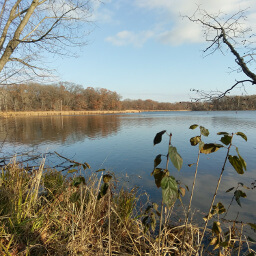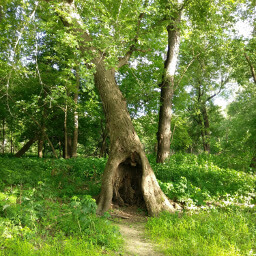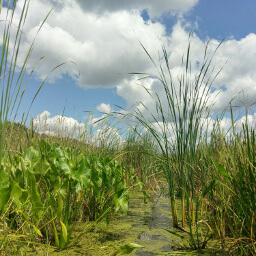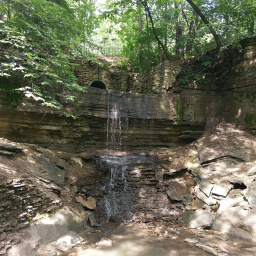| Rating | ★★★★☆(4/5) |
| Overall Difficulty | Moderate |
| Navigation Difficulty | Medium |
| Distance | 9 miles roundtrip |
| Time | 4 hours |
| Terrain | Mostly flat |
| Best Seasons | All |
| Family Friendly | No |
| Dog Friendly | Yes |
| Accessible | No |
Highlights
- Wilderness within a major metropolitan area
- Great wildlife viewing opportunities
Hike Summary
The Minnesota Valley National Wildlife Refuge is what I would call "urban wilderness", an oasis in the middle of a major metropolitan area and flanked by freeway bridges where the natural sights look like somewhere deep in the countryside. When you first arrive and park under one of the aforementioned freeway bridges, hearing the roar of cars and the screaming planes from the nearby airport, you'll probably think, "How is this noisy hike going to help me get my peaceful nature fix?" To start, look at the two beautiful pictures below, and you'll understand.
As soon as you start hiking the trail, the noise dithers away, replaced by the tweeting of thousands of birds (just look at the sky speckled with birds in the picture below), loud enough that it drowns out the din of the city (except for planes, no birds are that loud). I saw more wildlife on this hike than I would ever have expected, including two deer, many colorful birds, and even a few snakes (don't worry, they're harmless). The forest is also exceptionally diverse, with many different species of ferns and bushes and trees. The first part of the trail is easy to navigate, since you are walking on a thin strip of land between the Minnesota River and a lake. It can be particularly muddy; in some parts near the river, my feet sunk ankle deep into the mud. The sights are stunning, and as you can see in the picture below, the lake is so calm it mirrors the clouds in the sky. While this is quite the beautiful sight, it is also the perfect breeding ground for mosquitoes. Seriously, if you forgot your bug spray, you should really just go home and come back another day. Eventually, the noise level starts increasing as you approach the Interstate 494 bridge. Turn right and walk underneath the bridge. This might not be the most appealing place, but I took some of my best photos during this portion of the hike because the trees no longer block the view of the lake. When you reach the other side of the lake, walk up the hill on the right (technically the south) side of the bridge (there is a paved trail on the left side, but it leads to the side of a busy freeway when you get to the top). Take a long walk heading west back across the bridge on a paved surface separated from the road by a concrete barrier, now enjoying an elevated view of the same scenery you saw below. From this vantage point, I spotted a deer in the forest below, so try to ignore the noise and watch the nature, just be on the lookout for cyclists since they are the main users of this bridge.Continue following the paved path until you reach the driveway for the official visitor center for the wildlife refuge. Stop inside so you can cool off, have a drink and a snack, and learn a little about the wildlife you can find here. Once back outside, be sure to stop by the overlooks for impressive views across the entire valley like in the picture below. To continue hiking, look for a walkway leading to a set of stairs down into the forest. Turn right at the trail intersection at the bottom of the stairs. When you reach the Long Meadow Lake Trail, turn left (there should be a sign, and you want to go the direction away from American Boulevard). This section of the trail was better maintained and seemed to have fewer bugs and more fellow hikers. The trail wraps around its namesake Long Meadow Lake, and you'll emerge from the forest into a wetland environment like pictured below. There are few trees along the lakeshore, so you'll have long vistas and much less shade until you return to the forest. Follow the trail straight, ending at a paved area underneath the highway bridge. Turn to the right and take the ramp to the pedestrian bridge over the river to the parking area where you started. I was thoroughly impressed with the quality of nature I experienced on this hike, and I look forward to trying trails in other portions of the wildlife refuge in the future. I hope you enjoy this hike as much as I did! Connect with me using the social media links below and share your adventures!
Important Information
Dogs are allowed on leash only. This particular route is much too long for a family friendly hike, but those with kids can instead drive to the visitor center where there is an excellent view and do a short hike on one of the best maintained portions of the Long Meadow Lake trail. This trail is available for hiking in all four seasons, though in the winter I would recommend starting at the visitor center since the road to the trailhead described here won't be as well plowed as Bloomington's city streets. The trails here are not groomed in winter and navigation may be difficult in parts, but it's definitely possible to do at least a portion of this hike then! Flooding is common in the spring, so check for trail closures before leaving. Bug spray is an absolute must during mosquito season unless you want to be eaten alive. Most people who visit the Minnesota Valley National Wildlife Refuge stick to the area near the visitor center; the further you hike from the visitor center, the fewer people you'll encounter -- solitude is possible, at least for short periods of time.
Directions
From Downtown Minneapolis, take Interstate 35W south to eastbound Minnesota Highway 62. Exit at Minnesota Highway 77 and head south. After crossing the bridge over the Minnesota River, take the exit for eastbound Minnesota Highway 13. Turn left at the first light, Silver Bell Rd. At the T intersection at the end of the road, turn right onto Nichols Rd. After passing under the bridge, look for the turnoff for the parking area on your right.
Google Maps Directions
Parking, Fees, and Facilities
Possibly free. It is unclear whether the lot is part of Fort Snelling State Park or the Minnesota Valley National Wildlife Refuge. Upon entering the lot, signs say you are entering Fort Snelling State Park (which implies you need to pay the $7 vehicle entry fee at the park office or have an annual permit on your windshield), but there were not any signs suggesting a fee is required to park in the lot or that there is any enforcement. The official Fort Snelling State Park map does not label this parking area either. I parked in this lot on a Friday afternoon without a permit and was fine, but the lot was empty except for a volunteer trail cleanup crew and their van. If you are afraid of getting a ticket, you can park along the road just outside of the parking lot worry free. You can also park for free at the visitor center in Bloomington and start the hike there.
Nearby Hikes

Lebanon Hills Regional Park, Minnesota
★★★★☆(4/5)

Fort Snelling State Park, Minnesota
★★★★☆(4/5)

Crosby Farm Regional Park, Minnesota
★★★★☆(4/5)

Hidden Falls Regional Park, Minnesota
★☆☆☆☆(1/5)





